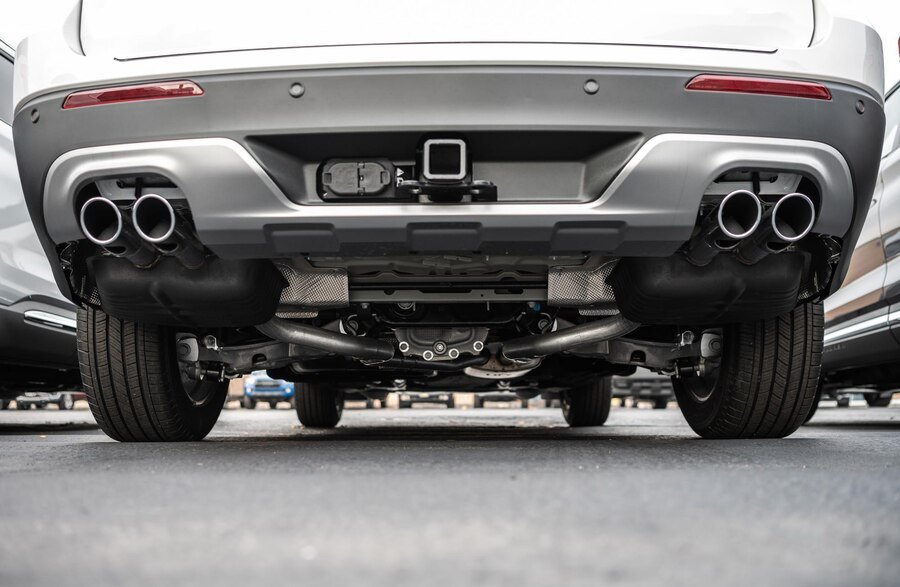The rear diffuser has become crucial in modern automotive design, particularly for performance-oriented vehicles. This feature, while subtle, plays a vital role in improving a car’s aerodynamics, stability, and overall driving experience. Let’s explore the fascinating world of rear diffusers, exploring their purpose, design, and benefits.
What Is a Rear Diffuser?
A rear diffuser is a panel located at the underside of the rear bumper in cars. Its primary purpose is to manage airflow as it exits underneath the vehicle, reducing turbulence and drag. Optimizing the airflow enhances a car’s aerodynamic performance and creates a more stable driving experience.
How Does a Rear Diffuser Work?
Rear diffusers work based on the principles of fluid dynamics. Air flows under the car and is compressed due to limited space. The diffuser expands this space toward the rear, allowing the air to slow down and grow smoothly. This controlled transition minimizes drag and creates downforce, improving the vehicle’s grip and stability.
Materials Used in Rear Diffusers
Rear diffusers are made from materials that balance durability, weight, and cost. Common materials include:
Carbon Fiber: Lightweight yet strong, carbon fibre is ideal for high-performance cars.
ABS Plastic: Affordable and durable, commonly used in everyday vehicles.
Aluminium: Offers a good balance of strength and weight but is less common in modern designs.
Types of Rear Diffusers
Not all rear diffusers are created equal. Different designs cater to varying needs, from aesthetics to performance.
Flat Diffusers: Simple in design, effective for improving aerodynamics in most cars.
Finned Diffusers: Equipped with vertical fins, these provide superior airflow management and are often seen in sports cars.
Custom Diffusers: Tailored for specific vehicles, offering performance and a personalized look.
The Role of Fins in a Rear Diffuser
Fins are vertical structures integrated into many diffusers. They help channel the airflow more effectively, preventing turbulence and ensuring smoother expansion of air. The strategic placement of fins is critical to optimizing a diffuser’s efficiency.
Rear Diffuser vs. Front Splitter
While both rear diffusers and front splitters are designed to improve aerodynamics, they serve different purposes. The front splitter manages airflow at the front, reducing lift and increasing front-end grip. In contrast, the rear diffuser stabilizes airflow at the back, contributing to overall balance.
Installation of a Rear Diffuser
Installing a rear diffuser requires precision. While some vehicles come with built-in diffusers, aftermarket options are widely available. Professional installation is recommended to ensure proper alignment and functionality. DIY enthusiasts can install them with the right tools and instructions, but incorrect placement can reduce effectiveness.
Rear Diffuser in Motorsport
In motorsport, every detail matters, and rear diffusers are no exception. Racing cars use highly specialized diffusers to maximize downforce without compromising speed. These components are meticulously designed, often incorporating advanced materials and technology.
How Rear Diffusers Impact Fuel Efficiency
By reducing drag, rear diffusers contribute to better fuel economy. While the impact is more pronounced at higher speeds, even everyday drivers can notice slight improvements in mileage over time.
Rear Diffuser Maintenance
To maintain optimal performance, rear diffusers require regular inspection and cleaning. Dirt and debris can accumulate in the fins, reducing their effectiveness. Cleaning with mild soap and water and checking for damages is essential, especially for carbon fibre models.
Are Rear Diffusers Worth the Investment?
For performance enthusiasts and car aesthetics lovers, rear diffusers are undoubtedly worth the investment. They offer tangible benefits in handling and fuel efficiency while elevating the car’s appearance. However, their value depends on the type of vehicle and driving conditions.
Legal Considerations for Rear Diffusers
When installing aftermarket diffusers, it’s essential to check local regulations. Some jurisdictions may have restrictions regarding vehicle modifications, including the size and shape of diffusers.
Popular Cars with Rear Diffusers
Many high-performance vehicles come equipped with factory-installed rear diffusers. Popular models include:
Lamborghini Aventador
McLaren 720S
BMW M3 and M4
Audi RS Series
These cars showcase how rear diffusers integrate seamlessly into design and functionality.
Future Trends in Rear Diffuser Design
As automotive technology evolves, rear diffusers are also seeing innovations. Active diffusers, which adjust based on driving conditions, are becoming increasingly common. These adaptive systems promise even better aerodynamic performance and efficiency.
Conclusion
The rear diffuser is more than just a design element; it’s a critical component that improves a car’s performance, efficiency, and aesthetics. Whether you’re a car enthusiast or someone looking to upgrade your vehicle, understanding rear diffusers can help you make informed decisions. With their growing popularity, these features are set to become even more sophisticated.
FAQs
Q1: What is the primary purpose of a rear diffuser?
A rear diffuser optimizes airflow under the car, reducing drag and improving stability through downforce.
Q2: Can a rear diffuser improve fuel efficiency?
Yes, rear diffusers can contribute to better fuel economy by reducing aerodynamic drag by reducing aerodynamic drag, particularly at high speeds.
Q3: Are rear diffusers only for sports cars?
No, rear diffusers can be installed on various vehicle types, though they are most common in performance-oriented cars.
Q4: How much does a rear diffuser cost?
The cost varies based on material and design, ranging from $100 for basic models to several thousand dollars for high-end or custom options.
Q5: Is professional installation necessary for the diffuser?
While DIY installation is possible, professional installation ensures proper fitment and optimal performance.



